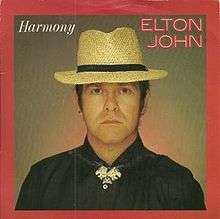Harmony (Elton John song)
| "Harmony" | |
|---|---|
 UK single cover | |
| Single by Elton John | |
| from the album Goodbye Yellow Brick Road | |
| A-side | "Bennie and the Jets" (US) |
| B-side | "Mona Lisas and Mad Hatters" (UK) |
| Released |
|
| Recorded | May 1973 at Château d'Hérouville, France |
| Genre | Rock |
| Label | |
| Writer(s) | |
| Producer(s) | Gus Dudgeon |
"Harmony" is a song written by Bernie Taupin and Elton John that was originally released by Elton John on his 1973 album Goodbye Yellow Brick Road. In the U.S. it was released as the B-side of the "Bennie and the Jets" single in 1974, and in the U.K. it was released as a single in 1980 with "Mona Lisas and Mad Hatters" on the B-side. It has also been covered by many artists, including Diana Ross, Zac Brown Band and Jesse Malin.
Lyrics and music
On their face, the lyrics of "Harmony" are addressed a lover who has returned to him after a long absence.[1] He wonders if she only returned to him because he is the only friend she has left, but expresses his love regardless.[1] Although the lyrics are optimistic, James Perone points out that aspects of the music, such as a modulation to a minor key suggest that the singer's happiness may only be temporary.[1] The Elton John Scrapbook author Mary Anne Cassata interprets the song as a "two-minute forty-five second dirge of despair...that somehow soared with hope enough to make Brian Wilson proud."[2] Elton John biographer Elizabeth J. Rosenthal interprets the song more metaphorically.[3] Rosenthal views the song as being about John's "love affair with music."[3] In this interpretation, John is expressing his devotion to harmony, and the "luscious" harmonies in the song are confirmation of this devotion.[3] The drawing out of the song's last note suggest to Rosenthal that John's relationship with music will last.[3]
Rosenthal also notes a relationship between "Harmony" and John's 1998 song "If the River Can Bend." She compares lyrics from "Harmony":
- Harmony and me
- We're in pretty good company
- Looking for an island
- In our boat upon the sea,
with lyrics in "If the River Can Bend" linking nautical images about a returning lover to the "harmony" the lover previously created.[3] Rosenthal thus interprets the theme of "If the River Can Bend" as expanding on that in "Harmony" to encompass the musical partnership between John and Taupin.[3]
Single release
"Harmony" was a candidate to be the 4th single from Goodbye Yellow Brick Road, following the title song, "Saturday Night's Alright for Fighting" and "Bennie and the Jets."[4] However, a 4th single would have been released too close to John's next album Caribou, so instead it was released as the B-side of "Bennie and the Jets" in the U.S.[4] John believes that it would have been a hit had it been released, and Rolling Stone Magazine critic Andy Greene concurs.[4][5] But DJM Records eventually released the song as a single in 1980 in the U.K. in 1980, backed with "Mona Lisas and Mad Hatters" to support the compilation album The Very Best of Elton John.[3]
Reception
Despite its belated and limited single release, "Harmony" has been a fan favorite.[5] It made several radio stations' Top 40s, and ranked as the #1 song for three weeks by WBZ-FM in Boston.[4] It was also rated the #6 song of 1974 by WBZ.[4]
Cassata rates "Harmony" as one of "the best John-Taupin" compositions, describing it as "brief but ethereal."[2] Rosenthal praises John's piano playing, Nigel Olsson's drumming and Del Newman's orchestral arrangement.[3] Ultimate Classic Rock critic Matthew Wilkenning described "Harmony" as a "gorgeous ballad."[6] Classic Album Sunday's founder Colleen Murphy regards "Harmony" as a personal favorite, describing it as "poignant."[7]
John has often performed "Harmony" live in concert.[2]
Cover versions
Diana Ross released her version of "Harmony" on the 2012 expanded edition of her 1976 album Diana Ross.[8] Jesse Malin covered the song on his 2008 album On Your Sleeve.[9] Allmusic critic described this version as "a barfly with a smile's nocturnal take" on the song.[9] The Zac Brown Band covered the song on the 40th anniversary deluxe edition of Goodbye Yellow Brick Road.[10]
References
- 1 2 3 Perone, J.A. (2012). "Goodbye Yellow Brick Road (1973)". The Album: A Guide to Pop Music's Most Provocative, Influential, and Important Creations. Praeger. ASIN B00BCR4JKC.
- 1 2 3 Cassate, M.A. (2002). The Elton John Scrapbook. Citadel Press. pp. 96–97. ISBN 9780806523224.
- 1 2 3 4 5 6 7 8 Rosenthal, E.J. (2001). His Song: The Musical Journey of Elton John. Billboard Books. pp. 64, 446, 504. ISBN 9780823088935.
- 1 2 3 4 5 "GYBR Song-by-Song: Harmony". eltonjohn.com. Retrieved 2015-06-20.
- 1 2 Greene, A. (March 14, 2014). "Elton John and Bernie Taupin Look Back At 'Goodbye Yellow Brick Road'". Rolling Stone Magazine. Retrieved 2015-06-21.
- ↑ Wilkening, M. (March 26, 2014). "Elton John, 'Goodbye Yellow Brick Road' (40th Anniversary Edition) – Album Review". Ultimate Classic Rock. Retrieved 2015-06-20.
- ↑ Murphy, C. (March 21, 2014). "Guest column – Classic Album Sunday's Colleen Murphy on Elton John's Goodbye Yellow Brick Road". Q Magazine. Retrieved 2015-06-21.
- ↑ Kellman, A. "Diana Ross 1976: Special Edition". Allmusic. Retrieved 2015-06-20.
- 1 2 Jurek, T. "On Your Sleeve". Allmusic. Retrieved 2015-06-20.
- ↑ Erlewine, S.T. "Goodbye Yellow Brick Road". Allmusic. Retrieved 2015-06-20.
